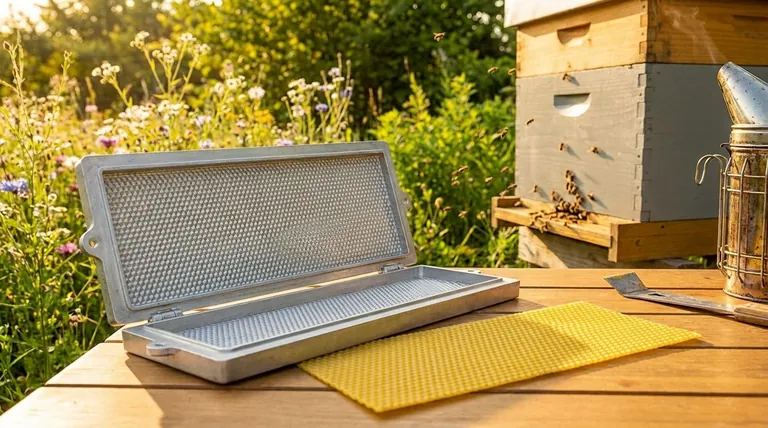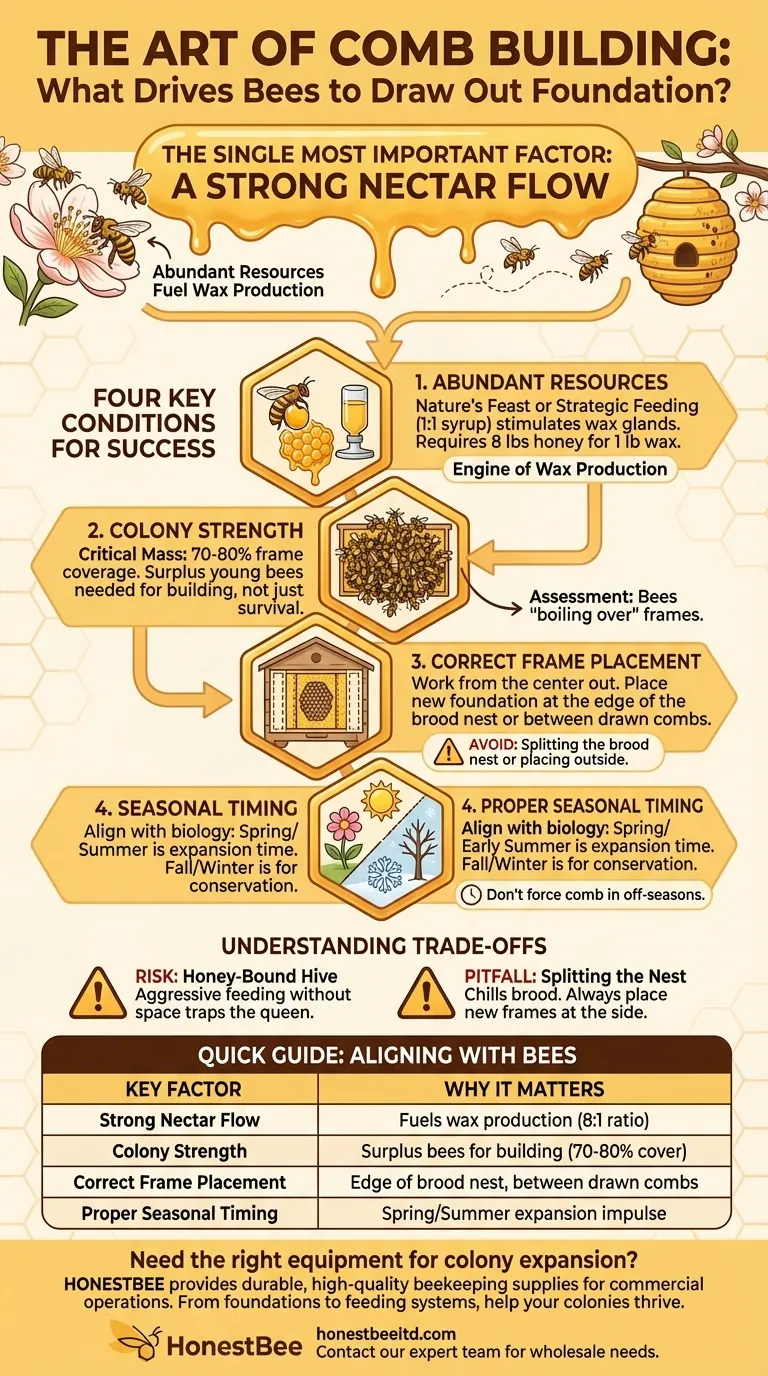The single most important factor for bees to draw out foundation is a strong nectar flow. When abundant nectar is available, bees can consume it and produce the massive amount of wax required for comb construction. Without this incoming resource, either from natural foraging or supplemental feeding, wax production grinds to a halt.
While a strong nectar flow is the primary trigger, successfully encouraging bees to build comb requires a holistic approach. You must align four key conditions: abundant resources, a strong colony, correct frame placement, and proper seasonal timing.

The Engine of Wax Production: The Nectar Flow
The entire process of comb building is fueled by food. Understanding this connection is the first step to managing it effectively.
Why Nectar is Non-Negotiable
Beeswax is not gathered; it is produced. Worker bees consume large amounts of nectar or honey, which they metabolize to secrete wax flakes from special glands on their abdomens.
It takes roughly 8 pounds of honey to produce just 1 pound of wax. This costly biological process is only undertaken when resources are plentiful and the colony needs to expand.
When Nature Falls Short: Strategic Feeding
If the natural nectar flow is weak or nonexistent (a "dearth"), you must step in. Feeding the bees a 1:1 sugar-to-water syrup by weight mimics a natural nectar flow.
This supplemental feeding provides the raw carbohydrates necessary to stimulate their wax glands and fuel construction, effectively tricking the colony into "expansion mode."
It's a Numbers Game: Colony Strength
A small, weak colony will not draw out foundation, regardless of the nectar flow. Their priority is survival, not expansion.
The "Critical Mass" for Comb Building
Drawing comb requires a large population of young worker bees. A strong colony has enough members to perform all necessary tasks simultaneously: foraging, nursing brood, guarding the hive, and producing wax.
A weak colony must dedicate all its energy to thermoregulation and caring for the small amount of brood they have. They simply do not have the surplus population to spare for building projects.
Assessing Your Colony's Readiness
A colony is typically ready to draw comb when the bees are covering at least 70-80% of the frames in their current box. If you open the hive and see bees "boiling over" the tops of the frames, they have the numbers needed to expand.
Location, Location, Location: Frame Placement
Bees are ruthlessly efficient. They build where it makes the most sense for the colony's immediate needs, which means working from the center of the hive outwards.
The Logic of the Brood Nest
The core of the hive is the brood nest, where the queen lays eggs and young bees are raised. The colony's primary impulse is to expand this area.
Therefore, bees will always prioritize drawing out foundation placed at the edge of the existing brood nest, where the queen can immediately lay.
The "Next-Door Neighbor" Principle
To encourage bees to work on a new frame, place it directly adjacent to a frame that is already full of brood or honey. A more effective method is to place a new foundation frame between two fully drawn combs.
This strategy leverages the bees' instinct to connect and fill in gaps within the active cluster. Frames on the far outside of the box will almost always be the last to be touched.
Understanding the Trade-offs and Pitfalls
Forcing bees to build comb can have unintended consequences if not done with care and observation.
The Risk of a "Honey-Bound" Hive
Aggressive feeding without enough space for the queen to lay can backfire. The bees may fill the brood cells with syrup, effectively trapping the queen and halting brood production. This is known as the hive becoming "honey-bound."
The Danger of Splitting the Brood Nest
Never place a bare foundation frame in the center of the brood nest. This creates a gap that the colony may struggle to keep warm, potentially chilling and killing the developing brood on either side. New frames should always go to the side of the brood cluster.
The Reality of Seasonal Timing
You cannot fight the beekeeping calendar. Bees are biologically programmed to expand in the spring and early summer. In late fall and winter, their instinct shifts entirely to conservation and survival.
Attempting to force comb-building during these periods is futile and wastes colony resources.
Making the Right Choice for Your Goal
Apply these principles based on your specific situation.
- If your primary focus is establishing a new colony: Provide consistent 1:1 syrup feeding to simulate a strong nectar flow and give them the resources to build their foundational home.
- If your primary focus is expanding a strong hive: Add new foundation frames one or two at a time, placing them between drawn combs on the edges of the brood nest during a natural nectar flow.
- If your primary focus is surviving a nectar dearth or winter: Stop adding new foundation and ensure the bees have enough stored honey to last. Do not stimulate expansion when their instinct is to contract.
By understanding and aligning with the bees' natural priorities, you can guide their incredible construction efforts with precision and success.
Summary Table:
| Key Factor | Why It Matters |
|---|---|
| Strong Nectar Flow | Fuels wax production; bees need 8 lbs of honey to make 1 lb of wax. |
| Colony Strength | A strong colony has surplus bees for wax building; aim for 70-80% frame coverage. |
| Correct Frame Placement | Place new foundation between drawn combs at the edge of the brood nest. |
| Proper Seasonal Timing | Spring/early summer is best; avoid forcing expansion in fall/winter. |
Need the right equipment to support your colony's expansion?
As a leading wholesale supplier to commercial apiaries and distributors, HONESTBEE provides the durable, high-quality beekeeping supplies your operation needs to succeed. From foundations and frames to feeding systems, our products are built to help strong colonies thrive during critical building phases.
Contact our expert team today to discuss your wholesale needs and how we can help you maximize honey production and colony health.
Visual Guide

Related Products
- Notebook Style Beeswax Foundation Mould Wax Foundation Mold
- Food Grade Plastic bee Foundation for Bee Frames
- Electric Beeswax Foundation Machine With Operating Tray and Wax Foundation Roller
- Electric Flatting and Embossing Machine with Tray for Beekeeping
- Colorful Silicone Beeswax Foundation Mold Mould for Beekeeping
People Also Ask
- What is required when using wax foundation in beekeeping frames? Essential Support for Strong Combs
- How do bees build their honeycomb? A Marvel of Collective Engineering and Efficiency
- How is beeswax foundation installed and what are its characteristics? Boost Hive Health Naturally
- What is beeswax foundation made of? A Guide to Stronger, More Efficient Hives
- Can beeswax foundation be recycled or reused? A Guide to Sustainable Beekeeping



















